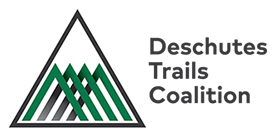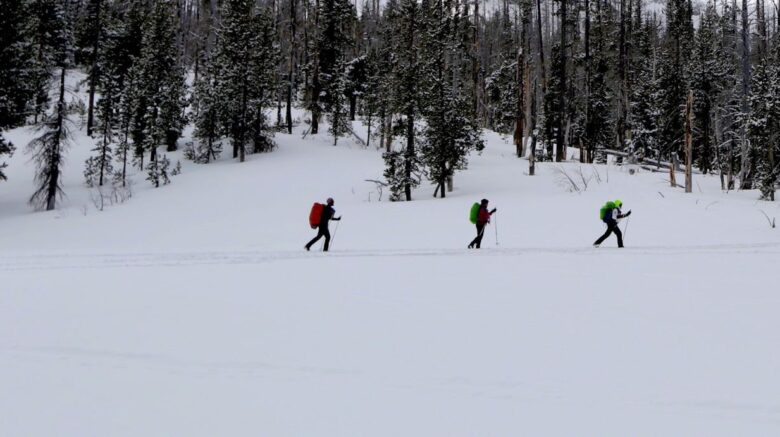Snow has arrived just in time for the holidays. Hooray!
This also means the typical holiday trail crowds are on their way. With more people sharing the trails during this ‘peak’ time, a little fresh-snow refresher might be in order. Here are five things to keep in mind about sharing and caring for our trails as you head out on skis, snowshoes, fat bikes, or your feet:
Be aware of high-use trail areas If you’re a local, you likely already know that the Deschutes National Forest’s winter sno-parks along Century Drive from Bend to Mt. Bachelor get busy–fast. These popular areas offer the trifecta: easy trail access, multiple use trails and ample parking. As you plan your adventure, keep in mind that Virginia Meissner, Wanoga, Swampy Lakes, Vista Butte and Dutchman Sno-Parks will all fill up quickly, with often hundreds of trail users on the trails on a given day. Plan perhaps to go outside of peak times, which are holidays and weekends, and especially in the morning.
Try exploring lesser-known trails and sno-parks Spend just a little extra time traveling or researching lesser-known trails, and you’ll likely reap the rewards of fewer people and more parking. Try the Three Creeks Sno-Parks outside of Sisters, Oregon; head south toward La Pine to Newberry National Volcanic Monument, where several cross-country ski trails head off from 10-Mile Sno-Park. Or, check out Walton Lake and Bandit Springs in the Ochoco Mountains outside of Prineville.
Be respectful and aware: nighttime adventures There’s simply nothing like silently gliding over snow under the stars or a full moon. Night or day, remember to be reverent of others that may be out there: people, and all the forest’s wildlife. Keep night experiences serene by keeping groups small. Give wildlife a head start without scaring them; gently make your presence known as you go. And, of course, bring plenty of layers, stick together and be prepared to keep everyone safe!
Always practice Leave No Trace principles With thousands of forest visitors a week, it’s crucial that we practice and encourage Leave No Trace principles. Wherever you go, there should be no evidence from your visit. In winter, pack out everything you bring, including food scraps and human waste. When visiting shelters, certain birds like “camp robbers” and chipmunks may seem “cute”, coming very close looking for human food handouts. DON’T DO IT. Feeding wildlife disrupts their natural rhythms and the forest’s food chain.
- Be prepared Winter is also a time when those with less snow experience might be inspired to venture out Whether new to snow sports or a winter veteran, when the weather is cold, everyone should follow these sound safety practices:
Dress appropriately by wearing and carrying layers, avoiding cotton. When cotton gets wet, it doesn’t dry and can lead to hypothermia.
Know where you’re going. Share your plans with someone and the time you expect to return. Bring plenty of water and food.
A headlamp is also good to have in your pack during these short days of early winter.

SPORTS-SPECIFIC WINTER TRAIL ETIQUETTE
Once you’re on your way, each snow sport comes with its own set of guidelines. The intent of these is to enhance every user’s experience and reduce impact on our forests. When you bring your best-etiquette self to the Deschutes and Ochocos trails, everyone–including our wildlife–wins.
Here are some rules of thumb for each type of adventure:
A Note to Hikers:
If you’re on foot, walking on snow can go south in a hurry. If you are hiking, be considerate and understand that your footprints can have a big impact on ski, fat bike and snowshoe trails. Do not hike on groomed trails or in ski tracks. If you must, then hike two feet off of ski trails. Try hiking on roads like Tumalo Falls up Skyliners Road, or Shevlin Park in town.
Winter Fat Tire Biking Etiquette
Fat biking is a fun wheeled way to explore more winter terrain. If your tires are 3.8 inches or wider, your bike gets ‘fat bike’ status. Narrower than that, please leave the bike at home!
Keep these few things in mind::
No riding on ski trails. Skiing and fat biking don’t go together, as tire tracks destroy ski tracks and groomed surfaces. Great riding can be found on closed winter roads out of Dutchman Flat or the trails at Wanoga Sno-Play groomed for this purpose, or try Tumalo Falls and the McKenzie Pass Highway.
Air down. Adjust your tire pressure to the conditions, between 3-5 PSI. The softer the conditions, the softer your tires should be to ensure your tracks have the least impact.
Ski Trail Etiquette

With many people on the trails at once and two types of skiing, it’s important to know who has the right-of-way. Meissner Nordic gives this list of ski trail etiquette guidelines:
Ski on the right hand side of the trail. If there are two sets of tracks on the wider trails, stick to the right side. With one set of tracks on narrower trails, use the below guidelines:
Pass on the left when over taking another skier on a downhill or narrow trail. Announce your presence by stating “On your left”.
Downhill skiers have the right-of-way. The downhill skier has right-of-way. On steeper sections of trail, the uphill skier should consider stopping and moving to the side of the trail.
Be considerate skiing side-by-side When out with friends, please be aware of others’ usage on the trail. Consider skiing single file on busy or narrow trails.
Respect the skate lane and classic tracks. The skate lane is not for wide groups to spread out, it is for skate skiing! If set tracks are icy/too slick, classic skiers should stay far to the side and yield to skate skiers.
Children and beginning skiers have the right-of-way. Intermediate / advanced skier always yield the classic track to children / beginners.
Snowshoeing Trail Etiquette
Follow snowshoe trails When heading out from a multi-use trailhead, snowshoers should follow the designated snowshoe trails. In the Deschutes National Forest, these are blue diamonds with yellow snowshoers.
Stay off ski tracks. If there is no designated snowshoe trail, always stay TWO FEET off of ski trails. If in an area with groomed trails, do not travel on the flat groomed area next to ski tracks. This is specifically for skate skiing, and your tracks ruin the surface for skiers.
Avoid “post-holing” If you have to remove your snowshoes at any point, do so off of the trail. Otherwise, you may break through the snow and create deep holes that can be dangerous and also damage the trails for others.
At some point, no matter what type of travel, everyone has to use their best judgment out there. So, approach every situation with a smile–and enjoy!


